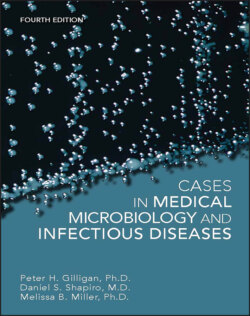Читать книгу Cases in Medical Microbiology and Infectious Diseases - Melissa B. Miller - Страница 23
Direct fluorescent-antibody stains
ОглавлениеThe development of monoclonal antibodies has enhanced both the sensitivity and the specificity of staining techniques that use antibodies to detect microbes in clinical specimens. The most widely used staining technique that incorporates the use of antibodies is the direct fluorescent-antibody (DFA) stain. In this technique, a highly specific antibody is coupled to a fluorochrome, typically fluorescein, which emits an “apple-green” fluorescence. The antibody binds specifically either to antigens on the surface of the microbes or to viral antigens expressed by virally infected cells, which can be visualized under the fluorescent microscope (Fig. 7). This technique is rapid, usually requiring 1 to 2 hours. In the hands of a skilled operator, the test is highly specific, although it frequently has a sensitivity of only 60 to 70% compared with bacterial culture. Because of its rapidity, the test has been used to detect some relatively slow-growing or difficult-to-grow bacteria, such as Bordetella pertussis and Legionella pneumophila. For respiratory viruses and herpesviruses, the sensitivity of this technique approaches 90% of the sensitivity of culture. However, the development of molecular amplification techniques for the detection of viral agents has demonstrated that DFA sensitivities can be as low as 50%, but may range up to 80% for some viruses. As result, many laboratories have replaced DFA with molecular amplification for organisms such as B. pertussis, herpesviruses, and respiratory viruses.
Figure 7
DFA staining is frequently used for the detection of microbes that cannot be cultured. DFA is the method of choice for detection of the nonculturable fungus Pneumocystis jirovecii, a common cause of pneumonia in people with AIDS. DFA is much more sensitive than other commonly used staining techniques, such as silver, Giemsa, or toluidine blue O staining. Likewise, for the gastrointestinal protozoans Giardia lamblia and Cryptosporidium parvum, DFA staining has been found to be much more sensitive than examination of wet mounts or the use of trichrome (for Giardia) or modified acid-fast stain (for Cryptosporidium). Molecular amplification techniques are also beginning to be deployed to detect these organisms as well and may soon replace DFA testing.
